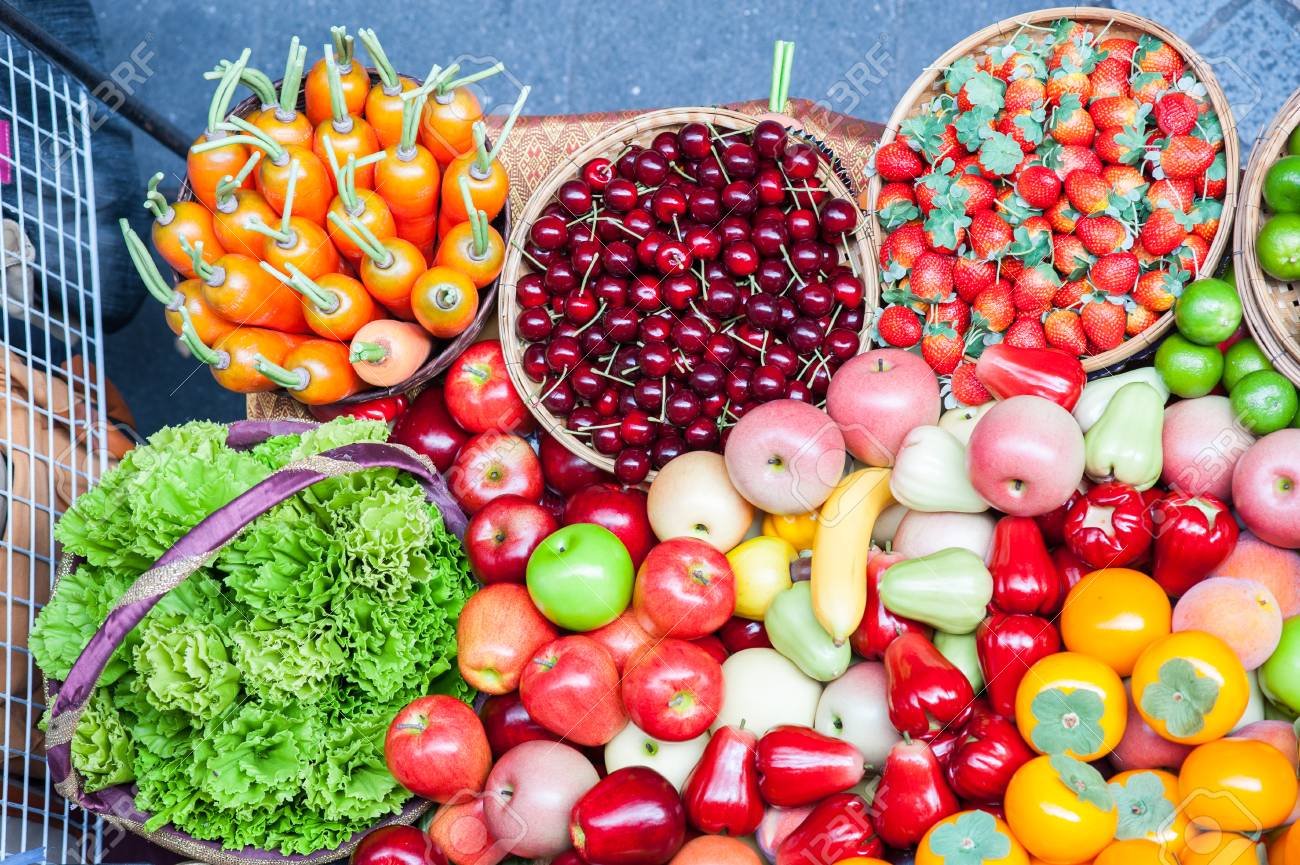Anahite Afshar
Montreal nutrition
EAT "COLORFUL", EAT HEALTHY!
. . . . . . . . . . . . . . . . . . . . . . . . . . . . . . . .
More than one third of adults in Quebec consume less than 5 servings of fruits and vegetables per day (1).
However, if there is one thing that all nutrition experts agree on, it is that eating a variety of fruits and vegetables every day is good for your health.
Rich in dietary fiber, water, vitamins, minerals, but also in many other phytochemicals with beneficial effects for the body, they are probably our best health insurance policy.
But did you know that these different compounds have natural pigments that give plants their beautiful colors?
Fruits and vegetables can be classified into five color groups (green, yellow/orange, blue/violet, red and white) where each of these groups gives us an indication of the nutritional value of the food.
Green
You've probably heard that you need a lot of green in your diet. Green vegetables are rich in many important nutrients such as calcium, iron and folate.
However, their green color comes mainly from these compounds:
Chlorophyll :
Used as a natural colorant, chlorophyll has long been recognized for its deodorizing effect (2). Body odors, breath, perspiration and flatulence for example, are improved by the consumption of chlorophyll. Moreover, chlorophyll has magnesium at its core. Magnesium is an important nutrient for cardiometabolic and bone health (3).
Foods rich in chlorophyll: kiwi, mint, parsley, basil, alfalfa, cabbage, spinach, avocado, asparagus, algae, etc.
N.B. Chlorophyll is sensitive to heat, so it is best to eat these foods raw to benefit from these properties.
Indoles:
Indoles are antioxidants that are believed to help reduce the risk of certain cancers (4).
Foods rich in indoles: Brussels sprouts, broccoli, bok choy, cabbage, turnip, cauliflower, etc.
Lutein:
Lutein, a yellow pigment also found in the retina of the eye, is believed to have a beneficial effect on eye health. Lutein present in plants would reduce the risk of cataract and would protect against the development of age-related macular degeneration (5).
Foods rich in lutein: spinach, asparagus, broccoli, kale, peas, watercress, corn, summer squash, winter squash, etc.
Yellow/orange
Yellow/orange fruits and vegetables, often rich in vitamin C (peppers, citrus fruits, mangoes, cantaloupe, pineapple, etc.), are colored by lutein and beta-carotene:
Beta-carotene:
Carotenoids, such as beta-carotene, are converted into vitamin A by the body, which helps maintain normal vision and contributes to skin, eye and immune system health (6).
Foods rich in beta-carotene: carrots, sweet potatoes, pumpkin, winter squash, red peppers, apricots, cantaloupes, kale, spinach, etc.
Blue/purple
Anthocyanins
Although the color of smurfs may seem unappetizing, the anthocyanins that provide the bluish hue of some fruits and vegetables have a very high antioxidant power and are believed to help prevent problems related to aging, cardiovascular disease and certain cancers (7). Moreover, these compounds are associated with the potential hypoglycemic effect of blueberries in diabetics (8).
Foods rich in anthocyanins: Blueberries, bilberries, blackberries, blackcurrants, plums, eggplant, cranberries, cherries, strawberries, raspberries, red grapes, etc.
Red
The red color of fruits and vegetables comes from beta-carotene and anthocyanins, but also from lycopene:
Lycopene
The consumption of lycopene, especially from tomatoes and tomato-based products, would be a protective factor against prostate cancer (9).
Foods rich in lycopene: tomato, watermelon, grapefruit
NB. The bioavailability of lycopene is increased by cooking tomatoes and the presence of fat.
White
White fruits and vegetables may seem less nutritious because of their light color, but they are still rich in several beneficial compounds, such as potassium and allicin.
Potassium
Potassium is an essential mineral for human health that contributes to the water balance in the blood and tissues, the maintenance of blood pressure and the proper functioning of nerves and muscles (10).
Foods rich in potassium: Banana, potato, onion, papaya, sweet potato, spinach, avocado, etc.
Allicin
Allicin is thought to have antimicrobial, lipid-lowering, antioxidant and antithrombotic effects, and therefore may help maintain heart health and prevent certain cancers (11).
Foods rich in allicins: garlic, onion, leek
N.B. Since alliinase, the enzyme that allows the formation of allicin and other sulphur compounds, is deactivated by heat, the properties of raw garlic are superior to those of cooked garlic.
So, the more colors you have on your plate, the more varied vitamins, minerals and phytochemicals you will have in your diet.
So, expand your palette and fill it with color!
References
Institut national de santé publique du Québec. Blanchet C., Plante C. and Rochette L. (2009). Food consumption and nutritional intake of Quebec adults.
Montgomery RM, Nachtigall HB. (1950). Oral administration of chlorophyll fractions for body deodorization. Postgrad Med. 8 (5) 401-404. Institute of Medicine of the National Academies. Dietary Reference Intakes for
Calcium, Phosphorus, Magnesium, Vitamin D, and Fluoride. National Academies Press, Washington, DC. 1997.
Health Challenge: https://www.defisante.ca/manger-mieux/fruits-et-legumes/la-couleur-cest- la-sante
Krinsky NI, Landrum JT &Bone RA. (2003) Biologic Mechanisms of the Protective Role of Lutein and Zeaxanthin in The Eye. Annu. Rev. Nutr. 23:171-201.
Dietitians of Canada: https://www.dietitians.ca/
Health Challenge: https://www.defisante.ca/manger-mieux/fruits-et-legumes/la-couleur-cest- la-sante
Grace MH & al. (2009). Hypoglycemic activity of a novel Anthocyanin-rich formulation from Lowbush Blueberry, Vaccinium angustifolium Aiton. Phytomedicine. 16 (5) 406-415.
Chan R, Lok K & Woo J. (2009). Prostate cancer and vegetable consumption. Molecular Nutrition & Food Research. 5 (2) 201-216.
Dietitians of Canada: https://www.dietitians.ca/
Tattelman E. (2005). Health Effects of Garlic. Am Fam Physician. 72 (01)103-106
. . . . . . . . . . . . . . . . . . . . . . . . . . . . . . . .
Anahite Afshar, Nutritionist-Dietitian PLT
anahite.afshar@cliniquealtermed.com


